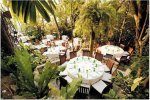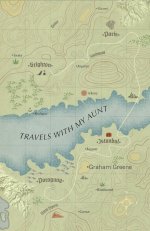Q is for Queluz
National Palace
Not far from Lisbon lies Queluz National Palace, with a sad story of a former resident.
The Royal Palace of Queluz is a beautiful, cake-like, Rococo structure in Sintra, Portugal, not far from the capital city Lisbon.
It’s not exactly haunted, but it has a sad story about one of its royal residents.
Also known as the National Palace of Queluz, originally it was designed in the 18th century to be a summer retreat for Portugal’s Prince Dom Pedro.
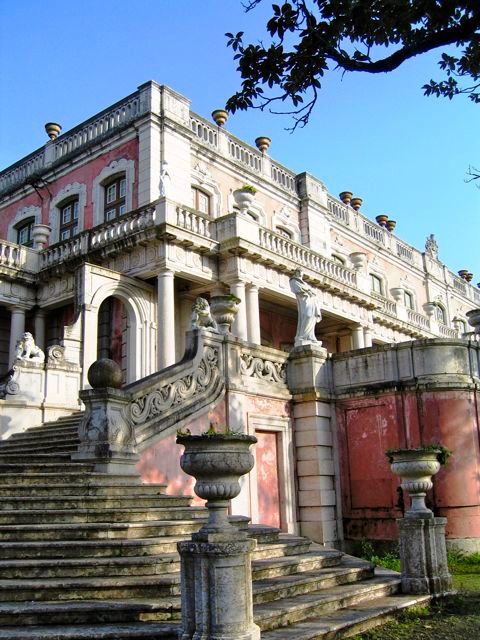 Steps up to Queluz National Palace
Steps up to Queluz National PalaceQueluz National Palace
The sad story of Queen Dona Maria
In the second half of the 18th century, Portugal was governed by the Marquis of Pombal, who encouraged the royal family to mind their own business and relax in a carefree manner in the country while he ran the affairs of state.
In 1760 he arranged for Prince Dom Pedro to marry the daughter of the king and heir to the Portuguese throne. The newlyweds, preferring this beautiful palace in Sintra as a favorite retreat, made it their principal home. (When Maria ascended to the throne, one of the first things she did was to dismiss Pombal.)
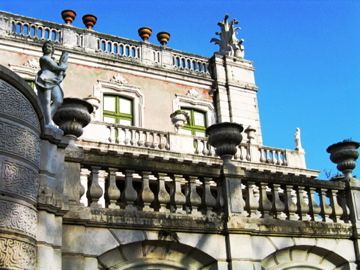
In the 26th year of their marriage, Dom Pedro died and Queen Maria, never known as a very stable person, descended into such a state of mental illness that her eldest son, later King João VI, was appointed Regent. The queen and her court remained virtually incarcerated at Queluz National Palace, where her madness would not be seen by any of her subjects.
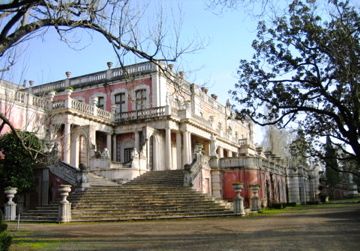 Europe's last great Rococo-style building.
Europe's last great Rococo-style building.The architecture of this fairy-tale-like building reflects the somewhat frivolous lifestyle led by the Portuguese royal family at the time of the construction. The playful architecture of Queluz National Palace in its own way represents the politics and social events predominant in Portugal at that time.
Palácio Nacional de Queluz - the Portuguese name - is known as one of the last great Rococo-style buildings in Europe. This architecture represents Portugal’s last extravagant cultural period following the discovery of gold in Brazil in 1690.
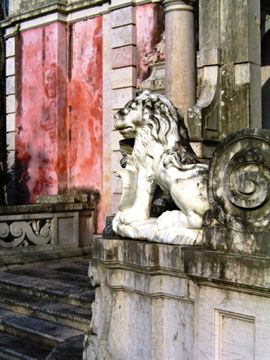
Under architect Mateus Vicente de Oliveira, construction began in 1747 and continued until the Great Earthquake of 1755 interrupted it. This event influenced the future direction of the design, with new concepts based on fear of another earthquake. This is why the buildings are long and low, making them more structurally stable than a single high building.
The public front view of the buildings, called the “Ceremonial Façade", features single-story wings on each side that form a three-sided courtyard of gardens, and faces directly onto a town square.
Oliveira designed the Ceremonial Façade, the nucleus of the palace, and some of the interior courtyards, but the gardens were another matter.
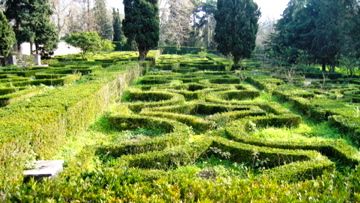
Queluz National Palace
- The famous gardens
The gardens of Queluz Palace are famous for their formal terraces, walkways, topiary, statuary and fountains, tall hedges of yew and cypress, magnolia and mulberry trees.
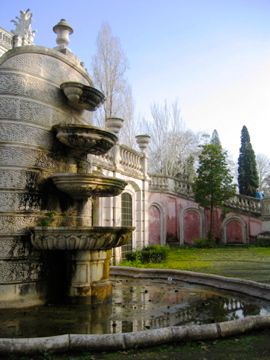 Fountains in the gardens of Queluz Palace
Fountains in the gardens of Queluz PalaceOne of the fountains, depicting dolphins, is said to have been designed by the Italian Baroque artist, architect and sculptor, Giovanni Lorenzo Bernini. But Bernini died in 1680, so I think this fountain must be a copy of his design.
Oliveira’s former
tutor, Frenchman Jean-Baptiste Robillon, designed the gardens, and also some of
the other buildings, and the Rococo interiors.
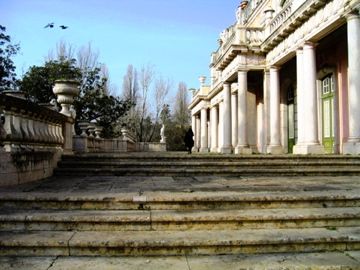 Steps up the side of Queluz National Palace
Steps up the side of Queluz National PalaceRobillon's entrance is reached by flights of ingeniously designed steps adorned with statuary that employ forced perspective.
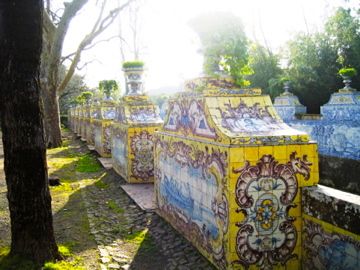 Azulejo tiles in the gardens of the Queluz
Azulejo tiles in the gardens of the QueluzThe famous azulejo tiles line many walls in the gardens as well as the walls of some of the canals, often showing a favorite Rococo theme of “amorous dalliance.”
A Dutch gardener contributed some Flemish influences, including the canals.
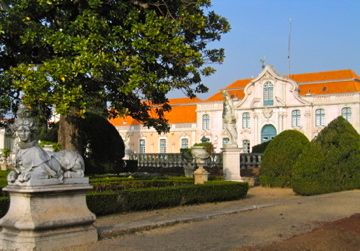 In this garden photo, on the left you can see one of two sphinxes the designer costumed in 18th-century dress, lending an element of fantasy to a classical sculpture figure.
In this garden photo, on the left you can see one of two sphinxes the designer costumed in 18th-century dress, lending an element of fantasy to a classical sculpture figure.Queluz National Palace
in the 20th century
When in a turmoil of revolution Portugal’s Carlos I was assassinated in 1908, the palace passed into the ownership of the state. When the monarchy fell in 1910, Queluz Palace was declared a National Monument.
In 1934 a major fire gutted the interior, requiring extensive restoration. Since then, the palace has been open to the public and has become a major tourist attraction.
Today the Dona Maria Pavilion wing of Queluz National Palace is used to house foreign heads of state when they visit Portugal. I imagine it would be kind of weird to visit someone else’s house and sleep in the place where Queen Maria died, insane.
Carolyn V. Hamilton



